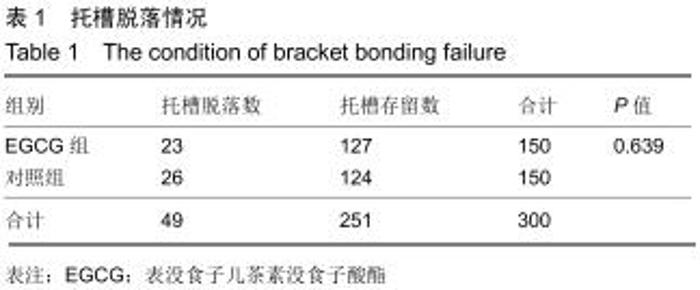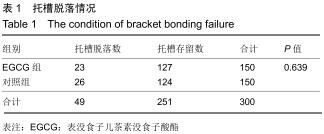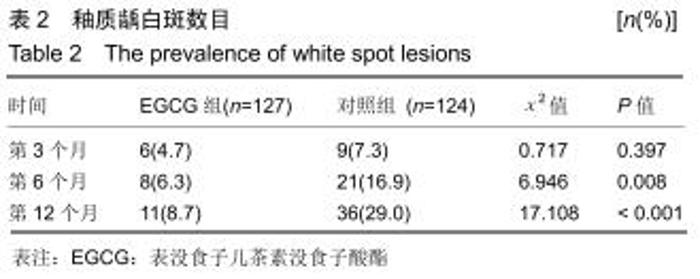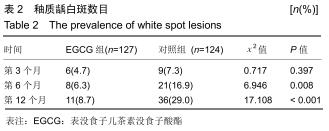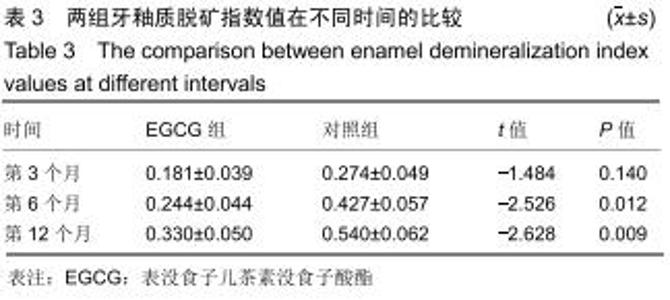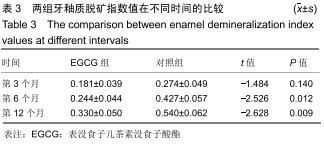|
[1] KHOROUSHI M, KACHUIE M. Prevention and Treatment of White Spot Lesions in Orthodontic Patients[J]. Contemp Clin Dent.2017; 8(1):11-19.
[2] 张晓慧,刘梅天.正畸粘结剂预防釉质脱矿的研究进展[J].牙体牙髓牙周病学杂志, 2018, 28(2):116-119,105.
[3] 刘佳,孙帅,李丽洁,等. 正畸治疗中釉质脱矿的预防[J].世界最新医学信息文摘, 2017(9):13-14.
[4] 李洪,卢英杰,梁晶.无托槽矫治与传统固定矫治的效果及牙周健康比较[J].中国当代医药, 2018,25(17):128-130.
[5] SONESSON M, BERGSTRAND F, GIZANI S, et al. Management of post-orthodontic white spot lesions: an updated systematic review. Eur J Orthodont.2016; 39(2): 116-121.
[6] WANG X, WANG B, WANG Y. Antibacterial orthodontic cement to combat biofilm and white spot lesions. Am J Orthod Dentofac. 2015;148(6):974-981.
[7] MARINHO VC. Cochrane reviews of randomized trials of fluoride therapies for preventing dental caries. Eur Arch Paediat Dent. 2009;10(3): 183-191.
[8] LIM BS, CHENG Y, LEE SP, et al. Chlorhexidine release from orthodontic adhesives after topical chlorhexidine treatment. Euro J Oral Sci.2013;121(3pt1): 211-217.
[9] SINGH BN, SHANKAR S, SRIVASTAVA RK. Green tea catechin, epigallocatechin-3-gallate (EGCG): mechanisms, perspectives and clinical applications. Biochem Pharmacol. 2011; 82(12): 1807-1821.
[10] CARNEIRO BM, BATISTA MN, BRAGA ACS, et al. The green tea molecule EGCG inhibits Zika virus entry. Virology. 2016; 496:215-218.
[11] RADY I, MOHAMED H, RADY M, et al. Cancer preventive and therapeutic effects of egcg, the major polyphenol in green tea. Egypt J Basic Appl Sci.2018;5(1):1-23.
[12] YANG H, GUO J, DENG D, et al. Effect of adjunctive application of epigallocatechin-3-gallate and ethanol–wet bonding on adhesive–dentin bonds. J Dent.2016;44:44-49.
[13] 高国兵,董素阁,王萌萌,等.不同浓度 EGCG 对玻璃离子水门汀抗菌能力及机械强度的影响[J]. 河南医学研究, 2018, 27(1): 3-5.
[14] HIRASAWA M, TAKADA K, OTAKE S. Inhibition of acid production in dental plaque bacteria by green tea catechins. Caries Res.2006; 40(3): 265-270.
[15] BESINGI RN, WENDERSKA IB, SENADHEERA DB, et al. Functional amyloids in Streptococcus mutans, their use as targets of biofilm inhibition and initial characterization of SMU_63c. Microbiology.2017;163(4): 488-501.
[16] BLACKMAN NJM, KOVAL JJ. Interval estimation for Cohen's kappa as a measure of agreement. Stat Med.2000;19(5): 723-741.
[17] GORELICK L, GEIGER AM, GWINNETT AJ. Incidence of white spot formation after bonding and banding. Am J Orthod. 1982; 81(2): 93-98.
[18] BUSCHANG PH, CHASTAIN D, KEYLOR CL, et al. Incidence of white spot lesions among patients treated with clear aligners and traditional braces. Angle Orthod.2018; 89(3): 359-364
[19] TUFEKCI E, DIXON JS, GUNSOLLEY JC, et al. Prevalence of white spot lesions during orthodontic treatment with fixed appliances. Angle Orthod.2011; 81(2): 206-210.
[20] SHUNGIN D, OLSSON AI, PERSSON M. Orthodontic treatment-related white spot lesions: a 14-year prospective quantitative follow-up, including bonding material assessment. Am J Orthod Dentofac.2010;138(2):136. e1-136. e8.
[21] SARDANA D, MANCHANDA S, EKAMBARAM M, et al. Effectiveness of self-applied topical fluorides against enamel white spot lesions from multi-bracketed fixed orthodontic treatment: a systematic review. Eur J Orthodont. 2019.
[22] 葛建,林芳,李明揆,等.表没食子儿茶素没食子酸酯 (EGCG) 生物活性研究进展[J].安徽农业大学学报, 2011,38(2):156-163.
[23] GAN RY, LI HB, SUI ZQ, et al. Absorption, metabolism, anti-cancer effect and molecular targets of epigallocatechin gallate (EGCG): An updated review. Crit Rev Food Sci.2018; 58(6): 924-941.
[24] VAN LANDUYT KL, SNAUWAERT J, DE MUNCK J, et al. Systematic review of the chemical composition of contemporary dental adhesives. Biomaterials.2007; 28(26): 3757-3785.
[25] YANG H, LI K, YAN H, et al. High-performance therapeutic quercetin-doped adhesive for adhesive–dentin interfaces. Sci Rep. 2017; 7(1): 8189.
[26] BRESCHI L, MARAVIC T, CUNHA SR, et al. Dentin bonding systems: from dentin collagen structure to bond preservation and clinical applications. Dent Mater.2018; 34(1): 78-96.
[27] SUN Q, GU L, QUAN J, et al. Epigallocatechin-3-gallate enhance dentin biomodification and bond stability of an etch-and-rinse adhesive system. Int J Adhes Adhes.2018;80: 115-121.
[28] BARBOSA IV, DE MIRANDA LADEWIG V, ALMEIDA-PEDRIN RR, et al. The association between patient’s compliance and age with the bonding failure of orthodontic brackets: a cross-sectional study. Prog Orthod. 2018;19(1):11-16.
[29] 何明宜,聂丽萍,古贵刚,等.临床正畸托槽脱落相关因素分析[J].北京口腔医学, 2008,16(1):29-31.
[30] 刘雨. 绿茶提取物EGCG对致龋菌变异链球菌抑制作用的研究[D].合肥:安徽医科大学, 2018.
[31] WU CY, SU TY, WANG MY, et al. Inhibitory effects of tea catechin epigallocatechin-3-gallate against biofilms formed from Streptococcus mutans and a probiotic lactobacillus strain. Arch Oral Biol.2018;94: 69-77.
[32] 陈秀兰.绿茶提取物 EGCG 抑制致龋菌变形链球菌生长, 产酸的实验研究[J].湖北科技学院学报(医学版), 2014(4):283-284.
[33] DU X, HUANG X, HUANG C, et al. Epigallocatechin-3-gallate (EGCG) enhances the therapeutic activity of a dental adhesive. J Dent.2012;40(6):485-492.
[34] CUTRESS TW, AINAMO J, SARDO-INFIRRI J. The community periodontal index of treatment needs (CPITN) procedure for population groups and individuals. Int Dent J.1987;37(4): 222-233.
[35] LESAFFRE E, PHILSTROM B, NEEDLEMAN I, et al.The design and analysis of split‐mouth studies: what statisticians and clinicians should know. Stat Med.2009; 28(28): 3470-3482.
[36] 宋小鸽,袁静.茶多酚急性, 慢性毒性实验研究[J]. 安徽中医学院学报,1999,18(2): 37-39.
[37] 杨解人,徐瑶.茶多酚对家犬的长期毒性实验研究[J]. 九江医学, 1999,14(4):196-198.
|
